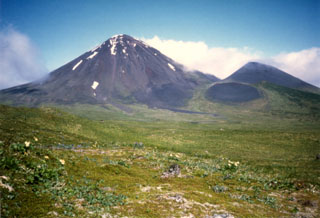Report on Semisopochnoi (United States) — 8 September-14 September 2021
Smithsonian Institution / US Geological Survey
Weekly Volcanic Activity Report, 8 September-14 September 2021
Managing Editor: Sally Sennert.
Please cite this report as:
Global Volcanism Program, 2021. Report on Semisopochnoi (United States) (Sennert, S, ed.). Weekly Volcanic Activity Report, 8 September-14 September 2021. Smithsonian Institution and US Geological Survey.
Semisopochnoi
United States
51.93°N, 179.58°E; summit elev. 1221 m
All times are local (unless otherwise noted)
AVO reported that eruptive activity at Semisopochnoi's North Cerberus crater continued during 7-14 September. Seismicity was elevated and characterized by periods of continuous tremor. Short-lived explosions lasting several minutes were detected daily in infrasound data. Small ash clouds from the explosions rose 3-4.6 km (10,000-15,000 ft) and dissipated within two hours. Sulfur dioxide emissions were detected in satellite images at altitudes less than 3 km (10,000 ft) a.s.l., sometimes extending downwind for hundreds of kilometers. During 7-9 September periods of lower-altitude ash emissions interspersed with voluminous steam plumes were observed in web camera images moving horizontally by the wind and rising no higher than 1.5 km (5,000 ft) a.s.l. The Aviation Color Code remained at Orange and the Volcano Alert Level remained at Watch.
Geological Summary. Semisopochnoi, the largest subaerial volcano of the western Aleutians, is 20 km wide at sea level and contains an 8-km-wide caldera. It formed as a result of collapse of a low-angle, dominantly basaltic volcano following the eruption of a large volume of dacitic pumice. The high point of the island is Anvil Peak, a double-peaked late-Pleistocene cone that forms much of the island's northern part. The three-peaked Mount Cerberus (renamed Mount Young in 2023) was constructed within the caldera during the Holocene. Each of the peaks contains a summit crater; lava flows on the N flank appear younger than those on the south side. Other post-caldera volcanoes include the symmetrical Sugarloaf Peak SSE of the caldera and Lakeshore Cone, a small cinder cone at the edge of Fenner Lake in the NE part of the caldera. Most documented eruptions have originated from Young, although Coats (1950) considered that both Sugarloaf and Lakeshore Cone could have been recently active.
Source: US Geological Survey Alaska Volcano Observatory (AVO)

